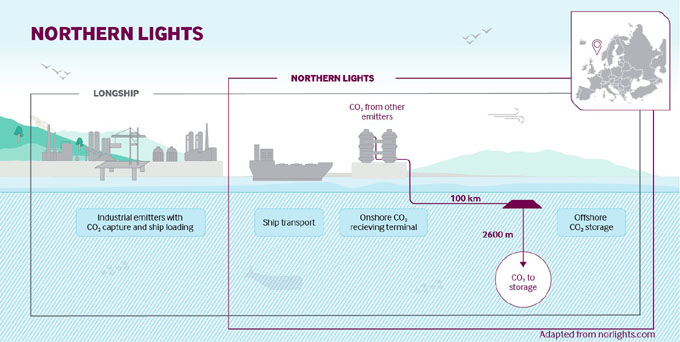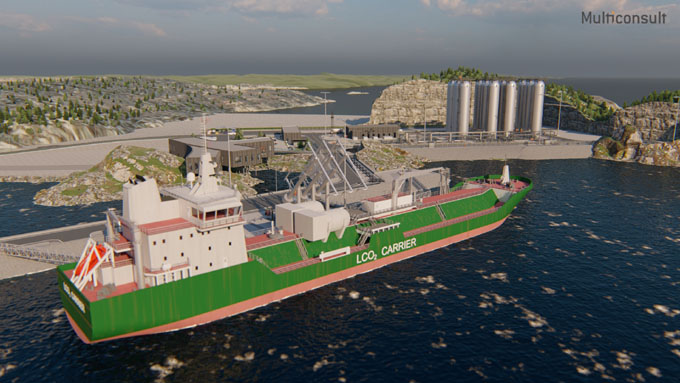On this ground-breaking carbon transport and storage project, RPS is supporting Northern Lights JV with acquiring baseline seismic data using their Osprey software.
About the Northern Lights
Northern LightsJV is a Joint Venture owned by TotalEnergies, Equinor and Shell and is the transportation and storage component of the full carbon capture and storage (CCS) value chain initiative by the Norwegian state called “Longship”. The project's first phase will be completed in mid-2024, with an initial capacity of up to 1.5 million tonnes of CO2 per year. The Northern Lights infrastructure is open to third parties and will deliver carbon transport and storage solutions as a service. Northern Lights holds Exploitation License 001, the first license for CO2 injection and storage in subsea reservoirs on the Norwegian Continental Shelf.

Map adapted from norlights.com
Monitoring for safe carbon storage on CCS projects
CO2, once captured, compressed and transported, can be injected into subsea reservoirs, usually depleted wells or saline reservoirs. Many pilot projects, such as the Sleipner CO2 storage project - running since 1996, have stored CO2 underground for decades. However, the right geological conditions must be present.
Once CO2 is injected into a subsea reservoir, it must be closely monitored to understand how the injected CO2 is causing geological changes in the reservoir or the well. For example, in the presence of water, CO2 forms carbonic acid that can cause severe corrosion to the infrastructure. Migration paths in the upper layers of geology that trap the CO2, can be formed by poor well construction or geological faulting.
The first step in instituting a CCS monitoring plan is to establish a baseline survey of the reservoir by acquiring 3D seismic data. Then subsequent surveys are taken so any changes in the reservoir or trapping layers can be detected and interpreted, and the CO2 plume development can be modelled.
Optimising 4D seismic data acquisition
Seismic survey design for 4D seismic interpretation must take a pragmatic approach that combines geophysical and logistical considerations. The quality of data is paramount, and at the same time, data collection costs must be efficiently managed. RPS has a solid track record of 4D seismic survey optimisation and had previously provided Equinor with expertise on the Sleipner CO2 storage project. We were selected to support Northern Lights on the seismic data acquisition for the baseline survey on this important project.
Before the survey, RPS optimisation specialists used Osprey, proprietary software, to model different acquisition options. The model considers the multiple infield simultaneous operations (SIMOPS) while the survey occurs. In the Norwegian North Sea, the location of the Northern Lights project, there are many shipping vessels and multiple construction projects in development.
Once in the field, the specialists use the optimised plan and Osprey software to assist with the daily management of the operation, making adjustments as required. The optimisation specialist communicates with other vessels so that everyone is up-to-date and working safely.
The planning of the baseline survey is critical. If the seismic data acquisition is inefficient, there are possible impacts on the subsequent surveys concerning data quality and project costs.
“RPS is excited to be supporting the seismic data acquisition that will be used to develop the underground storage of CO2 for the Northern Lights offshore storage. We recognise that CCS is an essential part of the energy transition and are eager to see this project move forward.” Keith Watt, Technical Director - Seismic survey optimisation and SIMOPS planning, RPS.
Background
Northern Lights enables the mitigation of industrial process emissions for which there is currently no scalable solution, accelerates the decarbonisation of European industry, and facilitates the removal of CO2 from the atmosphere.
Accelerating decarbonisation
Northern Lights are developing an open and flexible infrastructure to transport CO2 from capture sites by ship to a terminal in western Norway for intermediate storage, before being transported by pipeline for permanent storage in a reservoir 2,600 metres under the seabed.
Transport and storage facilities will offer safe and permanent underground storage to industries from across Europe.
The project is the transport and storage component of Longship, the Norwegian Government’s full-scale carbon capture and storage project Northern Lights will be the first ever cross-border, open-source CO2 transport and storage infrastructure network. Phase one of the project will be completed mid-2024 with a capacity of up to 1.5 million tonnes of CO2 per year.

CO2 receiving terminal at the premises of Naturgassparken industrial area in the municipality of Øygarden in western Norway.
- Once the CO2 is captured onshore, it will be transported by newly designed ships, injected and permanently stored 2,600 metres below the seabed of the North Sea.
- The CO2 receiving terminal will be located at the premises of Naturgassparken industrial area in the municipality of Øygarden in western Norway.
- The CO2 storage complex has been named Aurora and is part of Exploitation Licence EL001 which was awarded in January 2019.
- In March 2020, the Eos confirmation well was successfully drilled and completed, confirming the reservoir characteristics and storage capacity.
- The Northern Lights JV was launched in March 2021.
The Northern Lights JV ambition is to expand capacity by an additional 3.5 million tonnes to a total of 5 million tonnes, dependent on market demand. However, the receiving terminal, offshore pipeline, and the umbilical to the offshore template will be built to accommodate the additional volumes.
Both phases will offer flexibility to receive CO2 from European sources, in addition to the 800,000 tonnes of CO2 per year, which will come from Longship, assuming both of the initial Norwegian capture projects are realised.
KeyFacts Energy Industry Directory: RPS Energy l KeyFacts Energy News: Energy Transition

If you would like to discover more about KeyFacts Energy, contact us today and we can arrange a 15-minute online meeting to review our database of over 2,600 continually updated 'country-specific' oil and gas and renewable energy profiles from a selection of 144 countries. Find out how you can instantly identify companies with operational activity in your chosen country, 'fine-tune' your news or company selection based on industry category, energy type or regional location and additionally benefit from one to one contact with us to ensure maximum online and social media exposure for your company.
 KEYFACT Energy
KEYFACT Energy